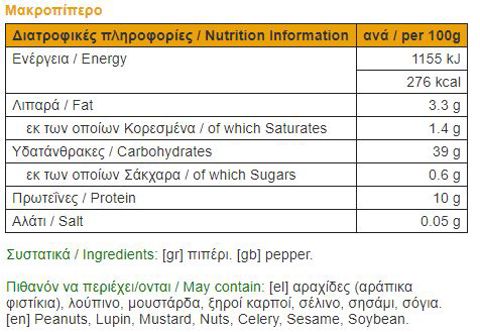FREE SHIPPING & DISCOUNTS
Free shipping on orders over 90 euros, enjoy 5% discount on orders over 40 euros. Get an additional 3% off on orders over 60 euros
shipping & paymentsLong pepper, or sometimes called Indian long pepper is a flowering vine of the Piperaceae family, cultivated for its fruit, which is usually dried and used as a spice. Long pepper is similar to the black, green and white pepper of the Piper nigrum plant, but is hotter than its close relatives. The word pepper derives from the Indian word for long pepper, pippali. The fruit of the pepper vine consists of small fruits, each the size of a poppy seed, embedded in the surface of a flower spike. As in Piper Nigrum, the fruit contains the alkaloid piperine, which contributes to the spicy taste.
The first reference to long peppers comes from ancient Indian manuscripts of Ayurveda, which describe in detail its medical and dietary uses. The plant arrived in Greece in the sixth or seventh century BC, although Hippocrates discussed it as a medicine rather than a spice. The ancient history of black pepper is often associated with and confused with that of the long pepper, but Theophrastus, in his first work on botany, distinguished the two of them. Romans knew of both and often referred to them as just piper. Pliny erroneously believed that both fruits came from the same plant. Gradually, black pepper began to replace long pepper in Europe and by the 14th century it had taken its place. Unfortunately, the quest for cheaper and more reliable sources of black pepper fuelled the Age of discoveries and only after the discovery of the American continents and of chili pepper did the popularity of long pepper fade away.
Today, long pepper is rare in general trade and hardly used in European cuisines. However, it is more common in vegetable pickles in India and Nepal, in some North African spice mixes, and in Indonesian and Malaysian cuisine. It is a popular spice at Indian grocery stores, where it is commonly called pippali. Long pepper is the main spice of Nihari, a national Pakistani dish. The active compound Piper lonam in long pepper has been studied and is thought to have anticancer activity, as it has been shown to kill some types of cancer cells.


Free shipping on orders over 90 euros, enjoy 5% discount on orders over 40 euros. Get an additional 3% off on orders over 60 euros
shipping & payments